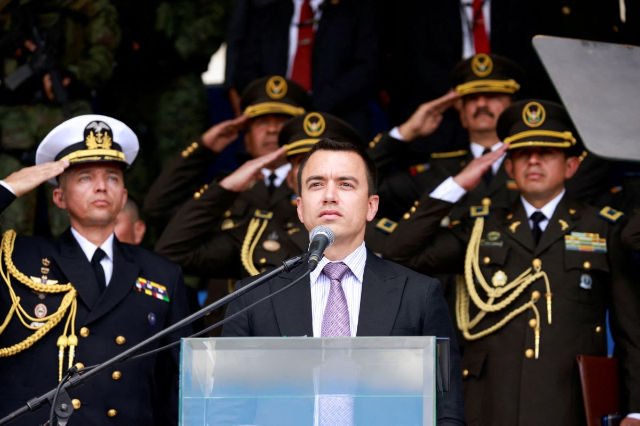 | Know better. Do better. |  | Policy, honestlyThe real-life impacts of policy decisions |
|
| | | By Lauren Crosby Medlicott | Freelance Journalist | | |
|  |
| The Legislation
Ecuador’s ”legalisation” of street gangs in 2007. This was a complex political process in which gang members formally entered into the political arena. In exchange for pledging to leave violence and criminality behind, the state formally recognised the gangs as sociopolitical actors.
The Impact
It couldn’t have been more dramatic. Live on Ecuadorian television in January, a group of masked gunmen stormed a news studio, forcing staff to the floor and calling for the newly elected president, Daniel Noboa, to end his crackdown on organised crime.
It was the culmination of a years-long deterioration in security for the country.
Just the day before, Noboa had declared a 60-day state of emergency after notorious gang leader José Adolfo Macías Villamar, known as Fito, disappeared from his cell at a high-security prison in the city of Guayaquil, where he was serving a 34-year sentence for crimes including drug trafficking.  Ecuador's President Daniel Noboa gestures at a ceremony to deliver equipment to the National Police, amid the ongoing wave of violence around the nation, in Quito, Ecuador, January 22, 2024. REUTERS/Karen Toro |
His apparent escape led to an explosion of violence with riots breaking out in prisons across the country. In the streets, there was a wave of arson attacks, car bombings and shootings.
But Noboa was defiant. In a radio interview, he promised to continue his pursuit of the gangs.
“We are in a state of war and we cannot give in,” he said.
Now, as Ecuador struggles with this unprecedented crime wave, and its people debate its causes, some experts are casting their minds back to a controversial piece of legislation from 2007.
Then President Rafael Correa introduced a raft of new security measures when he came into office that year, promising to reduce a burgeoning murder rate (22 per 100,000 people at the time).
The key, and most risky, element of his plan was this: he would, effectively, legalise street gangs.
Instead of taking a punitive approach, Correa allowed the gangs to remake themselves as “cultural associations” that could apply for government funding and benefit from social programs.
Many gang members took the opportunities afforded to them - some went to college, some studied law, some engaged in social work, and some undertook crime analysis, among other things.  A revolver and bullets lay on the ground after they were found during a joint police and military operation in a low-income neighbourhood, as the government continues its offensive against criminal gangs, in Duran, Ecuador, February 1, 2024. REUTERS/Santiago Armas |
“One of the reasons for adopting this inclusionary policy was to give gang members an alternative to join in organised crime,” David Brotherton, a sociologist at the City University of New York who has studied gangs in Latin America, told me.
“It was a prevention policy.”
Correa had watched the so-called war on drugs in the US closely and decided to do the exact opposite. Instead of working against the gangs, the government wanted to work with them.
“The more violence you put in, it just builds on itself,” Brotherton said, praising Correa’s move.
Iron Fist
At the same time, the government purged corrupt police officers from the force and trained new and existing officers in non-violent responses to problems on the streets or in the community.
Brotherton told me that the kids in the gangs “took the chance” and started seeing themselves as part of “pro-social” movements or quasi nonprofits, rather than as violent criminals.
By 2017, the murder rate was just five per 100,000 people – a more than 400% drop on 2007. Ecuador had become one of the safest countries in Latin America.
The policy, though, also had its critics, who believed it legitimised criminals. Some even believe that it led directly to the power the gangs have today – and the new wave of violence.  Soldiers get ready to enter cell block 3 at the militarized Litoral prison, as part of the measures taken by Ecuador's President Daniel Noboa to crackdown on gangs, during a media tour in Guayaquil, Ecuador, February 9, 2024. REUTERS/Santiago Arcos |
“President Correa exposed us when he made agreements with the gangs,” one 35-year-old woman in Guayaquil told me.
“He regularised their situation as social groups and opened doors to other countries to see us as a target for mafias and take charge of the groups here,” she said, referring to drug cartels from neighbouring Colombia and Peru who have since gained a foothold in Ecuador.
In 2017, ten years after the policy’s introduction, things changed.
A new president, Lenin Moreno, came to power and quickly distanced himself from Correa.
Over the next few years, the gang legalisation policies stuttered, according to Brotherton, and in 2019 he recalls gang leaders telling him that their connections to the State had all but ended.
Then, in 2020, COVID landed. And, as in many other countries, ordinary Ecuadorians were hit in their pockets as the economy flailed. Many former street gang members, experts say, joined drug cartels.
By 2023, Ecuador’s murder rate was back to new heights: 40 per 100,000.
Now, as Ecuador’s current crime wave escalates, its political classes seem united on the need for an iron-fisted approach to the gangs in common with other countries across the region, including El Salvador and Honduras.
While there are myriad factors that have led to the surging violence of recent years – high poverty rates, Ecuador’s location between the trafficking hubs of Colombia and Peru, and gang control of many of the country’s prisons among them - Brotherton believes the abandonment of the legalisation process shoulders most of the blame.
“Zero tolerance and militarised policing are not the answer,” he said. “Only through addressing the roots of crime can Ecuador once again be 'the island of peace.'”
Any views expressed in this newsletter are those of the author and not of Context or the Thomson Reuters Foundation. |
|
|
|